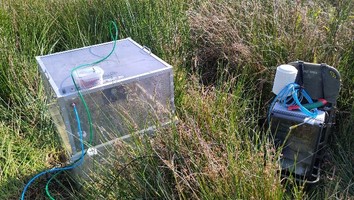Recording of greenhouse gases – A26 (EkG)

UHH/IfB O. Kaufmann
Project description
As part of the measures for the construction of the A 26 federal highway, western section, in the south of Hamburg, large quantities of peat are incurred as dredged material. According to an agreement with the Ministry for the Environment, Climate, Energy and Agriculture (BUKEA), this peat from the subsoil, formerly covered with clay, is to be restored of in a climate-friendly manner. Peat can be mineralized through aeration and release large amounts of relevant greenhouse gases into the atmosphere. For the purpose of climate-friendly placement, a peat conservation and development area (TEE area) of approx. 15 hectares was created in the immediate vicinity of the new freeway. Within this area, impermeable layers of clay underneath and an embankment at the edge enable the retention of precipitation water, which should lead to permanent waterlogging and thus reduced to completely suppressed aeration of the peat on the TEE area. By storing the peat to this TEE area, emissions of relevant greenhouse gases should be minimized.

UHH/IfB O. Kaufmann
The working group “Soils in the climate system”, headed by Prof. Dr. Lars Kutzbach, has many years of experience in recording and balancing the most relevant greenhouse gases carbon dioxide (CO2), methane (CH4) and nitrous oxide (N2O). As part of a research and development project with Deutsche Einheit Fernstraßenplanungs- und -bau GmbH (DEGES), the working group will conduct a comprehensive monitoring of greenhouse gas exchange dynamics between the TEE area and the atmosphere over several years, starting early in 2025. In this applied project, the gas dynamics will be measured, modeled and balanced at high frequency over the period of the research project. In addition, the working group is carrying out investigations on the quality and properties of the peat and the vegetation that has grown on it.
The research questions of the project are:
1. How much of the relocated peat will be mineralized?
2. Does the placement of the relocated peat in water-saturated conditions for as long as possible and without interruption achieve the desired almost complete prevention of additional emissions of carbon dioxide (and nitrous oxide)?
3. What role does the anaerobic decomposition of the relocated peat in a water-saturated environment, which produces the greenhouse gas methane, play in the greenhouse gas balance and how does it develop (over years and depending on vegetation succession)?
4. What effect does the change in land use of peat-rich river marsh soils from extensive grassland use with grassland-bed structures to peat conservation and development areas have on the greenhouse gas balance (carbon dioxide, methane and nitrous oxide fluxes) of these areas?
Staff at the Institute of Soil Science
- Project management: Prof. Dr. Lars Kutzbach
- Scientific coordination: Dr. David Holl
- Project coordination: Dr. Tim Eckhardt
- Research assistant (PhD student): Oliver Kaufmann
- Ongoing Master's thesis M. Bindner: “ Soil science characterization of a depomoorkultisol on a peat conservation and development area in the Elbmarsch”
- Duration: 16.08.2024 - 15.08.2029
- Project lead: Prof. Dr. Lars Kutzbach
- Sponsor: Deutsche Einheit Fernstraßenplanungs- und -bau GmbH (DEGES)
